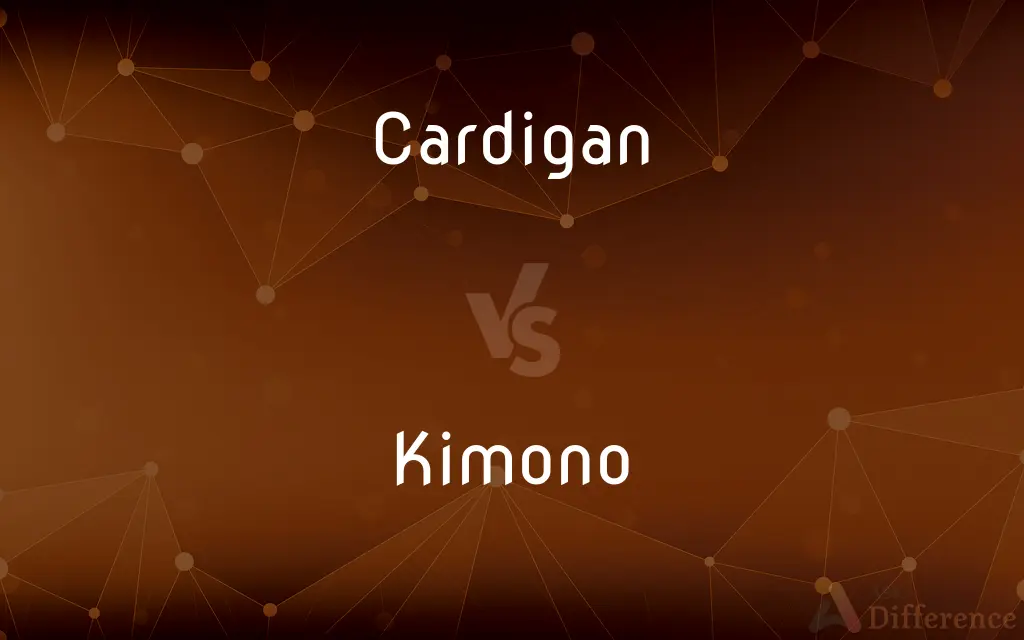Cardigan vs. Kimono — What's the Difference?
Edited by Tayyaba Rehman — By Urooj Arif — Updated on March 19, 2024
A cardigan is a type of knitted garment with an open front, commonly secured with buttons or a zipper, while a kimono is a traditional Japanese robe with wide sleeves and a wrap-around design.

Difference Between Cardigan and Kimono
Table of Contents
ADVERTISEMENT
Key Differences
Cardigans are versatile, knitted sweaters that open at the front and are often fastened with buttons, zippers, or sometimes left open. Originating from Europe, they are a staple in Western wardrobes and come in various styles, lengths, and materials, catering to different climates and occasions. On the other hand, kimonos are traditional Japanese garments characterized by their long sleeves, T-shape, and a wrap-around design secured with a sash called an obi. Kimonos are made from various fabrics and often feature intricate designs and patterns, reflecting Japanese aesthetic and cultural values.
Cardigans serve as a practical layering piece in casual to semi-formal attire, offering warmth and style flexibility. They can be easily paired with a wide range of outfits, making them suitable for various settings and seasons.
Kimonos, while also adaptable in modern fashion, carry a significant cultural heritage and are often worn during special occasions and ceremonies in Japan. The wearing of a kimono involves a specific dressing procedure and is accompanied by traditional accessories.
The distinction between cardigans and kimonos extends beyond their geographical origins to their construction, use, and cultural significance. Cardigans are primarily seen as a functional clothing item in everyday fashion, whereas kimonos are considered a symbol of Japanese tradition and artistry.
Comparison Chart
Origin
Europe
Japan
ADVERTISEMENT
Design
Open front, may have buttons or zippers
Wrap-around with wide sleeves, secured with an obi
Material
Knitted fabric (wool, cotton, synthetic)
Silk, cotton, synthetic fabrics
Occasion
Casual to semi-formal
Special occasions, ceremonies
Cultural Significance
Minimal
High, traditional and ceremonial attire
Compare with Definitions
Cardigan
A versatile garment worn over other clothing for warmth or style.
She wore a light cardigan over her dress to stay warm in the cool evening air.
Kimono
A long, wrapped garment with wide sleeves, worn for various occasions.
For the tea ceremony, she wore a formal silk kimono adorned with seasonal flowers.
Cardigan
Characterized by its open front, which can be buttoned or left open.
She preferred cardigans with an open front design for easy layering.
Kimono
A wide sash tied around the waist to secure the kimono.
He chose a contrasting obi belt to complement his dark-colored kimono.
Cardigan
Made from interlocking loops of yarn, providing texture and warmth.
His favorite cardigan was a thick, knitted one that kept him cozy in winter.
Kimono
Often features elaborate patterns and motifs, each with specific meanings.
Her kimono was beautifully crafted with crane motifs, symbolizing good fortune.
Cardigan
Serves both as a practical layer for warmth and a fashion statement.
The bright red cardigan added a pop of color and warmth to her outfit.
Kimono
Influences contemporary fashion, leading to kimono-inspired garments.
The fashion designer's latest collection included lightweight, kimono-inspired jackets for summer.
Cardigan
Available in numerous styles, including long, cropped, oversized, and fitted.
For a casual look, she chose an oversized cardigan with large pockets.
Kimono
Represents Japanese heritage, tradition, and artistry.
The museum exhibit on traditional attire featured kimonos as a key symbol of Japanese culture.
Cardigan
A knitted jumper fastening down the front.
Kimono
The kimono (きもの/着物, lit., "thing to wear" – from the verb "to wear (on the shoulders)" (着, ki), and the noun "thing" (物, mono)) is a traditional Japanese garment and the national dress of Japan. The kimono is a T-shaped, wrapped-front garment with square sleeves and a rectangular body, and is worn left side wrapped over right, unless the wearer is deceased.
Cardigan
A knitted garment, such as a sweater or jacket, that opens down the full length of the front.
Kimono
A long, wide-sleeved Japanese robe worn with an obi and often elaborately decorated.
Cardigan
A type of sweater or jumper that fastens up the front with buttons or a zipper, usually machine- or hand-knitted from wool.
Kimono
A loose, light robe worn chiefly by women.
Cardigan
A warm jacket of knit worsted with or without sleeves, especially a knitted jacket with sleeves that is fastened up the front with buttons or a zipper.
Kimono
A traditional Japanese T-shaped, wrapped-front garment with square sleeves and a rectangular body, now generally worn only on formal occasions.
Cardigan
A slightly bow-legged variety of corgi having rounded ears and a long tail.
Kimono
(loosely) A yukata.
Cardigan
Knitted jacket that is fastened up the front with buttons or a zipper
Kimono
A long robe-like garment in Western fashion, which may be open at the front, loosely inspired by the Japanese garment.
Cardigan
Slightly bow-legged variety of corgi having rounded ears and a long tail
Kimono
(regional) A bathrobe or dressing gown.
Kimono
A kind of loose robe or gown tied with a sash, worn as a traditional outer garment by Japanese women and men. Women may wear it with a broad sash called an obi, having a large bow in the back. At present (1998), most Japanese wear it only at home or on ceremonial occasions, western-style clothing being more common in the workplace.
Kimono
A similar gown worn as a dressing gown by women of Western nations.
Kimono
A loose robe; imitated from robes originally worn by Japanese
Common Curiosities
Can kimonos be worn casually?
While traditionally worn for special occasions, modern adaptations of kimonos can be styled for casual wear.
How do you care for a kimono?
Care for a kimono depends on its fabric; many require dry cleaning, especially silk kimonos, to preserve their quality and designs.
Can cardigans be worn in summer?
Lightweight cardigans made from breathable materials like cotton can be worn during summer for cooler evenings or air-conditioned environments.
What occasions are cardigans suitable for?
Cardigans are suitable for a wide range of occasions, from casual outings to semi-formal events, depending on their style and material.
Is wearing a kimono cultural appropriation?
Wearing a kimono respectfully and with an understanding of its cultural significance is generally accepted; however, it's important to be mindful of context and intent.
Are cardigans unisex?
Yes, cardigans are designed for both men and women, with styles varying across genders.
Is an obi belt necessary for wearing a kimono?
Yes, an obi belt is an essential part of wearing a kimono, both for securing the garment and for aesthetic purposes.
Do all cardigans have buttons?
No, cardigans can come with buttons, zippers, or no fastening at all, designed to be worn open.
What is the significance of kimono patterns?
Kimono patterns often carry symbolic meanings, such as seasons, nature, or wishes for happiness and longevity.
Can cardigans be formal?
While typically casual to semi-formal, cardigans made from fine materials like cashmere can be styled for more formal occasions.
Are cardigans suitable for all seasons?
Yes, cardigans come in a range of thicknesses and materials, making them suitable for all seasons.
Do kimonos come in different lengths?
Traditionally, kimonos are long, reaching the ankles, but modern styles and adaptations can vary in length.
Can cardigans be worn with formal attire?
Depending on the material and design, cardigans can be styled with formal attire, offering a smart, layered look.
How has the kimono influenced modern fashion?
The kimono has inspired various aspects of modern fashion, including loose-fitting garments, wide sleeves, and wrap-around designs.
What is a lightweight summer cardigan called?
A lightweight summer cardigan may be referred to as a "summer cardigan" or "light cardigan," often made from materials like cotton or linen.
Share Your Discovery

Previous Comparison
Unctious vs. Unctuous
Next Comparison
Moment vs. EventAuthor Spotlight
Written by
Urooj ArifUrooj is a skilled content writer at Ask Difference, known for her exceptional ability to simplify complex topics into engaging and informative content. With a passion for research and a flair for clear, concise writing, she consistently delivers articles that resonate with our diverse audience.
Edited by
Tayyaba RehmanTayyaba Rehman is a distinguished writer, currently serving as a primary contributor to askdifference.com. As a researcher in semantics and etymology, Tayyaba's passion for the complexity of languages and their distinctions has found a perfect home on the platform. Tayyaba delves into the intricacies of language, distinguishing between commonly confused words and phrases, thereby providing clarity for readers worldwide.















































